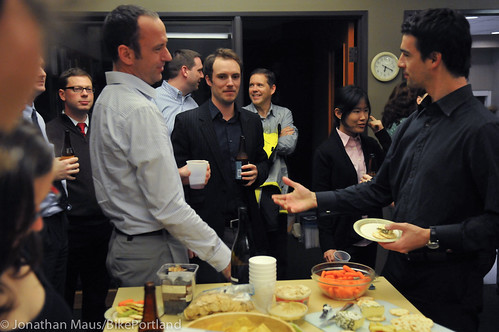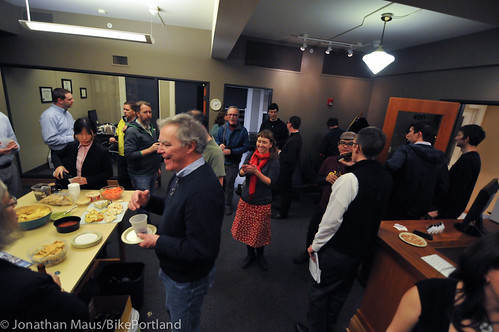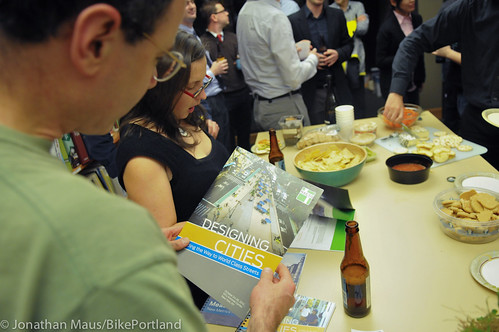
Councilor-elect Bob Stacey at Wonk Night.
(Photos © J. Maus/BikePortland)
Last night a solid crowd (about 37 people) showed up for our Wonk Night here on the 4th floor of the Title & Trust Building in downtown Portland. We met in the spacious lobby of Lancaster Engineering (which happens to be adjacent to my office) and enjoyed snacks, drinks, and hearty discussions.
The folks that showed up made just the right mix of officials, planning students, engineers, and citizen activists. Faces in the crowd included: Metro Councilor-elect Bob Stacey; ODOT Region 1 Active Transportation Liaison Jessica Horning; ODOT Region 1 Grant Manager Lidwien Rahman; PBOT Signals, Streetlights, and ITS Division Manager Peter Koonce; Oregon bike tourism advocate and bike journalist Russ Roca; Active Right of Way volunteer and northeast Portland neighborhood activist Ted Beuhler; animation expert Spencer Boomhower; bike advocate John Beaston; Portland Pedicabs owner Ryan Hashagen, and many others.
After giving everyone ample time to chat and meet each other, I shared some thoughts about my recent trip to New York City. I had also laid out some of the materials I picked up at the NACTO Designing Cities conference (which, for this wonky crowd, proved to be quite popular).

A big topic of discussion last night was street performance metrics and the shift away from traditional, auto-centric standards. While U.S. transportation engineering practice has always focused on auto speeds and capacity in determining whether or not a street design “works,” there’s a growing movement among advocates, engineers, and planners that are working to change that. As I reported last month, the NYC DOT is leading the charge on using a new set of metrics to measure street design performance (so is Portland, which I’ll get into more later in this post).
I also shared thoughts and answered questions about my general impressions about biking in Brooklyn and Manhattan. We talked about what New York City is doing well, what’s not working, and how it compares to bicycling in Portland. (Stay tuned for a separate post about that.)
Getting back to performance measures, Mike Ard and Todd Mobley from Lancaster Engineering gave us an update on the City of Portland’s efforts to revise their Level of Service (LOS) standards.
Mike said he (and most other traffic engineers of his generation) was trained as a civil engineer. As such, he was taught how to design structures based on rigid calculations and equations. But designing streets is often, “more art than science,” Mike said, and old LOS standards don’t give any leeway for new ideas or changing road use trends (like more people biking). “So it’s really about changing that mentality of trying to add 2+2=4 and everybody gets the same answer and realizing there might be different answers and that’s O.K.”
Todd then shared a local example of how the outdated LOS standards impact road design.
Lancaster is doing the traffic engineering around the forthcoming New Seasons in northeast Portland. They’ve identified the need for a new traffic signal at Broadway and 32nd. It would serve as a crucial north-south biking and walking connection between the Tillamook bike boulevard (to the north) and the future Sullivan’s Gulch trail (to the south). However, in order to get approval of the signal, Lancaster would have to show the City that it meets performance standards for the next 20 years. “So for us to do that,” Todd explained, “We’re better off showing that there aren’t any pedestrians or bikes because to the extent they are there, they impede auto traffic and that’s the sole metric the performance standard is based on.”
Todd said the 32nd/Broadway signal situation is a good example of how engineers have to take the “square peg/round hole approach” to try and make bike-friendly changes that will mesh with the existing performance standards.
The final topic of discussion was right hooks. Portland’s problems with preventing them is well-documented and Lancaster’s Brian Davis thinks it’s time to re-assess whether or not PBOT’s designs and implementations are actually working (you can read a blog post he wrote on the topic here). He shared the following slide and asked everyone if it looked familiar…

Right on cue, we all tried to nicely tell Brian his slide had a mistake and that the right-most lane shouldn’t have a straight arrow. But Brian’s point was that you never see this configuration on standard lanes — yet this is precisely the situation we have with bike lanes that continue straight while adjacent lanes go right. Brian then explained his concerns with several existing bike box locations (including the one at SW 3rd and Madison where Kathryn Rickson died). A heated exchange followed between Brian and PBOT staffer Peter Koonce about the existing designs and what the best options might be for improvements. Several folks spoke up about other things — beyond infrastructure — that we could do to improve the right-hook issue (like better education, equipment requirements, and law changes).
In the end, it became clear that PBOT needs to take another look at some of their green bike box/bike lane implementations. At this point, it seems like the idea of mixing zones at intersections (which PBOT is already doing at NE Multnomah) is the most acceptable/feasible solution.
I really enjoyed the discussions and ideas everyone shared and I hope those of you who were there feel the same way. I find it very valuable to bring smart people together in an informal, unofficial setting to hash out these important issues. We definitely want to host more of these in future. Feel free to recommend discussion topics. Thanks again for coming and thanks to Widmer Bros Brewing/Omission Beer for the sponsorship.





